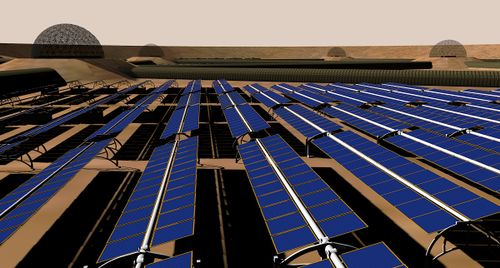Cost of energy on Mars
The cost of energy on Mars is one of the prime parameters required to analyse martian settlement scenarios. To go beyond generalizations and actually evaluate one scenario against another, the cost of energy and the cost of transportation to and from Mars need to be known, or at least estimated to compare on a common basis.
There can be no absolute answer to this question, as the cost of energy will vary depending on the source and the level of development of the colony. If all the energy producing equipment comes from Earth, the cost will be higher than if it is produced in-situ. As the settlement grows larger, economies of scale will come into play to reduce energy costs. As automation increases, and productivity increases accordingly, the cost of energy may go down significantly. Self replication of production equipment may eventually bring down the cost of energy to very small values. This will allow the realization of projects using energy on a scale that will be, literally, cosmic.
But before such a grand time comes, we can estimate a preliminary value for the cost of solar energy on Mars for a growing settlement of a few hundred to a few thousand settlers.
Solar energy
Design
For this estimation we will use a solar panel array built on Earth with the following characteristics:
| Characterisitic | References | |
|---|---|---|
| Efficiency | 30% | This would require fairly expensive multijunction production cells. Large volumes of production would keep the cost low. |
| Fill factor | 80% | This is a conventional average for good quality cells. |
| Mass | 3,5 kg/m2 | This is the NASA 2018 BIG challenge target of 3 kg/m2, plus 0,5 kg/m2 for ancillary equipment |
| Cost on Earth | 800 $/m2 | An estimate based on an average cost of 500$/m2 for conventional panels on Earth |
Transported by SpaceX Starship with other cargo and unfolded on Mars semi-autonomously. For the Cost of Transportation to Mars, we simply use the cost proposed by SpaceX for their transportation system, 500$ per kg to Mars.
The design is a tracking array. This allows for more energy production with the same peak power characteristics. The added complexity is estimated to be a small cost compared to the transportation costs from Earth. The moving mechanism would be fitted with elements allowing for a self cleaning phase for dust removal. The panels are mounted on a single rotating and extending boom, that allows for tight packing at transportation and can be unfolded using traction from a vehicle that can also serve to transport and set down the array, eliminating the need and mass of self extension mechanisms.
Solar panel energy production
The solar constant is estimated at 590 W/m2 over the whole year. Atmospheric dust losses are set at 20%. An additional surface dust factor of 10% is included. This lowers the solar illumination to 413 W/m2.







